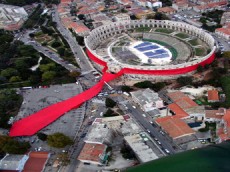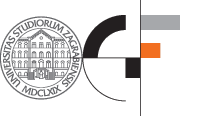Interesting about Croatia
Did you know that the tie originates from the Croats?
 Many events in the history of mankind eventually fade into oblivion, but others, leave their indelible marks for the entire world to see. More than 350 years ago, the Croats initiated one such influential occurrence. Although started in the 17th century in a small region on the Adriatic coast, the consequences of this event are still very much evident the world over. 600 million people now wear the ubiquitous symbol of Croatia around their necks, close to their hearts.
Many events in the history of mankind eventually fade into oblivion, but others, leave their indelible marks for the entire world to see. More than 350 years ago, the Croats initiated one such influential occurrence. Although started in the 17th century in a small region on the Adriatic coast, the consequences of this event are still very much evident the world over. 600 million people now wear the ubiquitous symbol of Croatia around their necks, close to their hearts.
Did you know that Croatia is the mother country of the tie? In his book, La Grande Histoire de la Cravate (Flamarion, Paris, 1994), François Chaille tells us about the appearance of this article of clothing and how it became fashionable.
"... Around the year 1635, some six thousand soldiers and knights came to Paris to give their support to King Louis XIII and Cardinal Richelieu. Among them were a great number of Croatian mercenaries led by a ban, or Croatian viceroy.
The traditional outfit of these Croats aroused interest on account of the unusual and picturesque scarves distinctively tied about their necks. The scarves were made of various cloths, ranging from coarse material for common soldiers, to fine cotton and silk for officers. This elegant "Croatian style" immediately enamoured the French, who were delighted by the new article of clothing, which had been previously unknown in Europe.
For the gallant French officers in the thirty-year war, the advantage of the Croatian neck scarf was its enviable practicality. In contrast to the lace collar that had to be kept white and carefully starched, the scarf was simply and loosely tied around the neck without need for any additional care. Just as elegant as the stiff, high collars, the new scarves were less awkward, easier to wear and remained visible beneath the soldiers’ thick, long hair.
Around the year 1650, during the reign of Louis XIV, the Croatian scarf was accepted in France, above all in court, where military ornaments were much admired. The fashionable expression, ’a la croate’, soon evolved into a new French word, which still exists today: la cravate. This innovation symbolized the height of culture and elegance. On his return to England from exile, Charles II brought with him this new word in fashion. Over the next ten years, this fashion novelty spread across Europe, as well as across the colonies on the American continent..."
Since that time in the 17th century, derivatives of the word croata have been present in many languages, (i.e., English, German, French, Portuguese, Italian), meaning cravat or tie. It follows then that Croatia is the mother country of the tie, as France is the mother country of high fashion, Brazil of coffee, Switzerland of cheese and watches, Portugal of port wine etc.
For those who are looking for an authentic Croatian tie, all roads lead to Croatia. More information about Croatian ties you can find at: http://www.croata.hr
TIES - from "WEVEN" (Dutch weavers magazine)
By Irene van der Horst
 In particular professions the tie often is the only thing by which one man can distinguish himself from the other. Over the past years I followed my husband to business-related get-togethers, and whenever I thought that his costume had that extra something, I was disappointed: all of a sudden all his colleagues turned out looking the same!
In particular professions the tie often is the only thing by which one man can distinguish himself from the other. Over the past years I followed my husband to business-related get-togethers, and whenever I thought that his costume had that extra something, I was disappointed: all of a sudden all his colleagues turned out looking the same!
The uniformity of this type of men's wear is so obvious, that a tie can be given as an accessory as a present. Giving any other piece of clothing as a present is considered a little bit odd, except from close relatives. The tie is both an ornament and a means to distinguish oneself. It was Luis Acosta who understood this and made his, now well-known, paper ties. Ornament you say? Absolutely. But what is the origin of the tie? Although there are different views on this, I would like to tell you what I think is the most likely.
Croatia, tie country. Where coffee stands for Brazil, fashion and champagne for France, tulips and wooden shoes are 'typically Dutch', the tie is considered Croatians national symbol. In 1635, during the Thirty-Year War, about six thousand Croatian soldiers and their officers came offering their support to Louis XIV and Richelieu. Amongst them were a large number of mercenaries under the command of a 'Ban', a Croatian viceroy.
These troops wore ties knotted around their necks. The officers wore ties of woven silk or high-grade cotton, while the ordinary soldiers wore ties of a lesser quality. Louis XIV thought this was so extraordinary that he introduced this 'Croatian style' and around 1650 the 'cravat' or 'Krawatte' in German, from the word 'Croatian' or 'Hrvat' became commonly worn in the army. The loose tie was a better sign of identification than the high-necked lace collar, which not only was very expensive, but also less visible under the long hair, which was the fashion in the seventeenth century.
Why did the Croatians wear ties? The very romantic answer to this question is that a girl, saying goodbye to her lover as he left for the army, took the shawl off her shoulders and gave it to him. He then tied this shawl around his neck. Not wanting to be outdone, his mates also started to wear shawls around their necks.
In the course of time the necktie has slowly evolved into the tie as we know it today. Presenting our husband or lover with a tie, we act, I am happy to say, from the same motives as the enamoured young girl in the early seventeenth century. Currently, Croatia is a producer of high-quality ties of only the very best silk.




